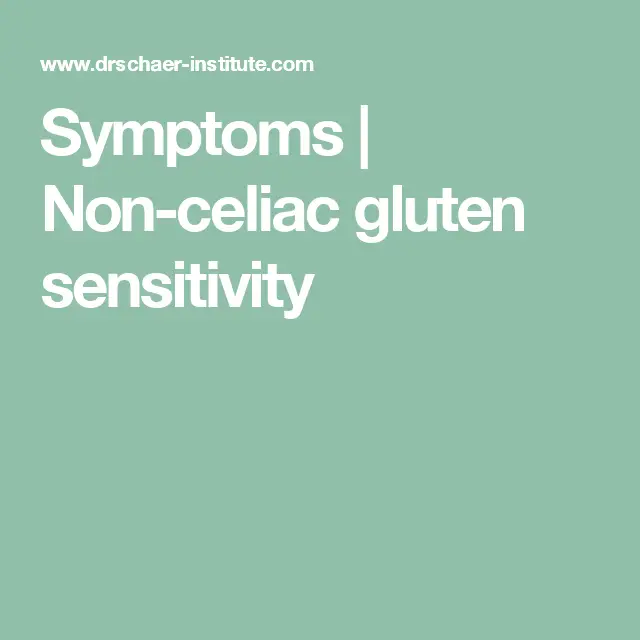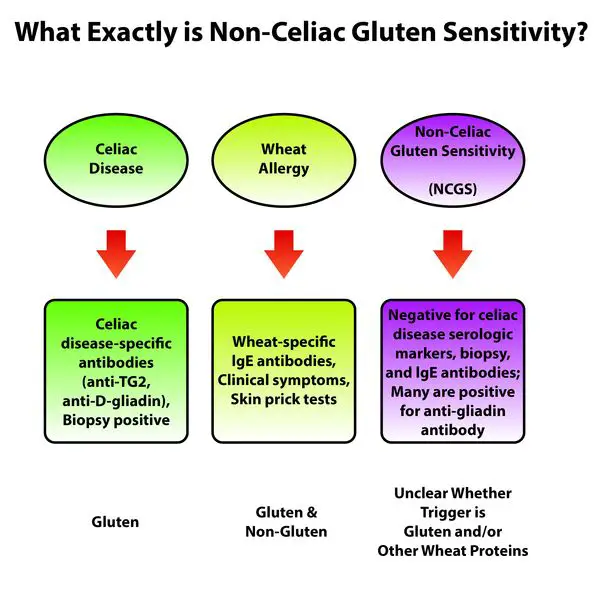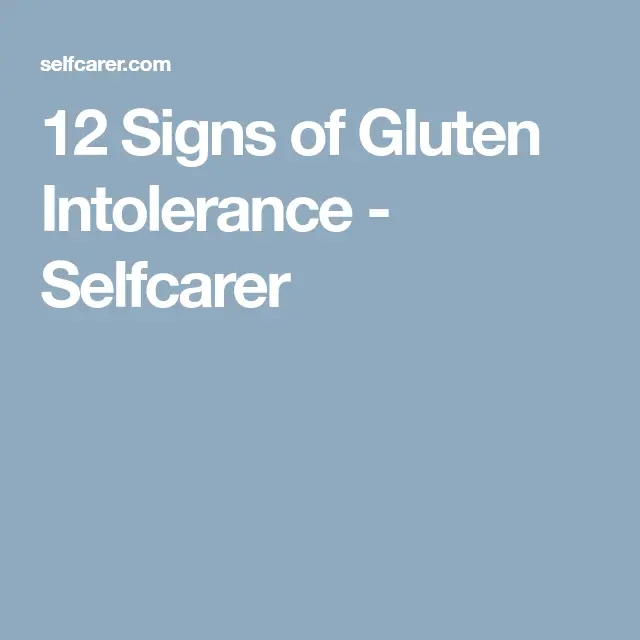How Are Celiac And Ncgs Diagnosed
A simple blood test can determine whether its highly probable that you have celiac disease, or not. Your immune system creates proteins called antibodies when it perceives a threat, such as a virus. Antibodies are tailored to fit and stick to a specific invader. Because their immune systems have mistakenly labelled gluten as an enemy, people with celiac disease have high levels of certain antibodies in their blood.
However, antibody testing is just the first step in diagnosing celiac disease. The definitive test is an endoscopic biopsy. During this procedure , a fine tube is passed from your throat down into your small intestine. A tiny camera on the end of the tube allows the gastroenterologist to examine the interior of the intestine. Another small tool attached to the tube is used to take a small sample of the intestinal lining. Afterward, a pathologist will examine the biopsied tissue to check for signs of damage and inflammation.
One thing thats important to know about both of these tests: the results will only be accurate if you are still regularly eating gluten-containing foods.
Unfortunately, NCGS is whats called a diagnosis of exclusion. That means your health care team has to rule out other conditions with similar symptoms before concluding you have NCGS. This includes getting a negative result on an antibody test for celiac.
Ethnicity And Gluten Sensitivity
Although a global analysis of gluten intolerance is yet to be done, a nationwide study was conducted in the United States. Over 400,000 biopsy results were examined to understand if ethnicity played a role in gluten intolerance and celiac disease. The following results were concluded after the study :
- Most of the Americans who were from the Punjab region of India were gluten sensitive.
- Significantly lower numbers of gluten-sensitive cases were reported by Americans of South Indian, East Asian, and Hispanic descent.
- Jewish and Middle Eastern people had no notable differences and had similar chances of being gluten-sensitive than any average American.
It is also worth mentioning that gender studies showed that both men and women had equal chances of being gluten-sensitive. Hence it can be inferred that gender does not play a role in this intolerance.
Distinguishing Wheat And Gluten
The evidence base for non-gluten components of wheat inducing symptoms in many patients with IBS is convincing.1416 Short-chain fructans are the main carbohydrate component of wheat and are poorly absorbed in the small intestine. This poor absorption increases delivery of water and fermentable substrates to the colon, which can result in increased gas production and GI symptoms in patients with IBS. Similarly behaved carbohydrates have been grouped together and termed FODMAPs: Fermentable Oligo-, Di-, and Mono-saccharides And Polyols. A diet low in FODMAPs is an evidence-based strategy leading to symptomatic improvement in 74% of patients with IBS.17 FODMAPs are found in a wide variety of foods, including lactose , excess fructose , fructans and fructo-oligosaccharides , galacto-oligosaccharides , and sugar polyols .1821 Wheat- and rye-derived products often contain the highest FODMAP content, predominantly fructans and GOS. Cereal products with the lowest FODMAP contents are mostly gluten-free, based on rice, oat, quinoa and corn ingredients.
Recommended Reading: Is Hillshire Farm Sausage Gluten Free
Common Symptoms Of Gluten Sensitivity/gluten Intolerance
There is a wide variety of symptoms associated with non-celiac gluten sensitivity, ranging from issues affecting the digestive tract to neurological complications and possibly even skin problems. Here are a few of the most common ones:
Social And Media Aspects In Choosing A Gfd

It is entirely premature to consider the rate of this condition because the criteria used for diagnosing it are still at the initial stages of the process . There are incredible difficulties in assessing the prevalence of NCWS correctly because most of the patients are diagnosed by practitioners or by the patients themselves. After all, the information is overwhelming on social media . A New Zealand study highlights some concerning data showing that despite only 1% of children having celiac disease, 5% are on a GFD . In the United States, a 0.55% prevalence rate of subjects on a self-reported GFD of 7762 persons aged six years or older between 2009 and 2010 was found . This rate is the lowest prevalence of self-reported NCWS in the literature, and it must be emphasized that this study was performed before the current interest and knowledge about NCWS. On the other hand, NCWS may affect up to 6% of the U.S. population and worldwide up to 13% if self-reported NCWS is considered . On the other hand, these data may not be reliable because of the subjectivity of some symptoms, the nonmedical approach, and the lack of a trustworthy biomarker estimating an exact prevalence rate .
Table 2 Conditions that may improve or worsen in non-celiac symptomatic subjects by adopting a gluten-free diet
You can also search for this author inPubMed
Don’t Miss: The Gluten Free Baking Company
How Do You Treat Ncgs
The only tried-and-true treatment is the same as that for celiac disease: ditching gluten entirely. “If you decide that you’re going to eliminate gluten, you’ve got to be committed to it 100 percent,â says Gans. “Not just a little, not when it’s convenient, not just when you’re at home.” Even a little of the stuff could set off the unpleasant symptoms associated with NCGS.
This means cutting out more than just regular bread and pasta: You’ll want to avoid any grains that contain gluten, including wheat, barley, rye, and triticale, a cross of wheat and rye. Scan the labels of any processed foods for added gluten as well as less obvious culprits derived from gluten-containing grains, such as brewer’s yeast and malt vinegar. As Gans points out, you can find gluten in everything from salad dressing to certain lipsticks.
The safest and most nutritious staples for GF eaters are mostly whole, unprocessed foods, including beans, legumes, grain-like seeds like quinoa or millet, nuts, Greek yogurt, vegetables, and fruit. On the processed food side, the popularization of the GF diet in recent years means you can find substitutes for everything from bread and pasta to soy sauce and beer.
Ology Of The Search Strategy
We performed a literature search in PubMed , Medline, Embase, Scopus, and Google Scholar using the following search terms in the title and abstract: Non-celiac gluten sensitivity or Non-celiac wheat sensitivity and diagnosis. We searched the key words alongside the following limitations: English language, human studies, and clinical trials. To qualify for inclusion , studies had to be randomized controlled trials . Only articles that were published in English-language peer-reviewed journals were included. Reference lists and reviews were further hand-searched to identify RCTs.
Also Check: Gluten Free And Weight Loss
Is There A Role For Mucosal Histology In The Ncws Diagnosis
The histopathology of NCWS is even still, like the clinical and laboratory features, a point of debate, and in many cases, there is extreme confusion. The fundamental assumption for a correct histopathological evaluation is the clinical and methodological assumption, namely, a precise selection of patients based on clinical and laboratory characteristics . Furthermore, an exact number of correctly oriented biopsies as in the case of celiac disease in the second duodenal portion and the bulb need to be carried out. The orientation of the same biopsies in which the use of cellulose acetate filters that are already cut for this purpose is also recommended to avoid false atrophies and imprecise T lymphocyte counts, and the role of some infections, such as in Helicobacter pylori-related gastritis or infestations caused by Giardia Lamblia or Cryptosporidium, which can cause an increased number of IELs without architectural abnormalities, cannot be sufficiently emphasized . Moreover, several drugs and autoimmune disorders produce the same histology findings. Other reported conditions associated with an increased number of IELs include Hashimoto thyroiditis, Graves disease, rheumatoid arthritis, psoriasis, multiple sclerosis, systemic lupus erythematosus and common variable immune deficiency.
The morphological elements evidenced in the Brescia experience are as follows:
How Is Gluten Intolerance Diagnosed
Your healthcare provider carefully reviews your symptoms and medical history. If they suspect you have a gluten intolerance, these are the next steps to confirm the diagnosis:
- Step 1: You eat a diet containing gluten for about six weeks. During this time, your healthcare provider performs blood tests and skin tests to rule out a wheat allergy or celiac disease. There isnt a gluten intolerance test.
- Step 2: If you dont have a wheat allergy or celiac disease, your healthcare provider will ask you to exclude gluten from your diet for at least six weeks. Keep a thorough record of your symptoms during this time, noting which symptoms improve.
- Step 3: If your symptoms do improve while youre on a gluten-free diet, you gradually reintroduce gluten back into your diet. If symptoms return, you likely have a gluten intolerance.
Recommended Reading: Wheat Allergy Vs Gluten Allergy
When To See A Doctor
If you think you might suffer from a gluten- or wheat-related condition, then its important that you talk to your doctor before diagnosing yourself or beginning any treatment on your own. An allergist or gastroenterologist can run tests and discuss your history with you to help reach a diagnosis.
Its especially important to see a doctor in order to rule out celiac disease. Celiac disease can lead to severe health complications, especially in children.
Because theres a genetic component to celiac disease, it can run in families. This means that its important for you to confirm if you have celiac disease so you can advise your loved ones to get tested as well. More than 83 percent of Americans who have celiac disease are undiagnosed and unaware they have the condition, according to the advocacy group Beyond Celiac.
Why Test For Gluten
You may be avoiding wheat or the gluten-containing foods you think caused a reaction. Many people are so accustomed to living with and being embarrassed by their uncomfortable gastrointestinal problems that they never consider asking for help. But finding out whats causing your symptoms may provide relief now and also help you avoid more serious issues in the future. There are long-term complications from undiagnosed gluten-related disorders: Untreated celiac disease can lead to issues including intestinal cancers, iron deficiency anemia, early onset osteoporosis and infertility.3
So, how do you know if your symptoms are caused by a wheat allergy, celiac disease or non-celiac gluten sensitivity? If you think you or a loved one has a gluten-related disorder, dont try to manage the problem on your own. A simple blood testtogether with your medical historycan help differentiate between allergy, celiac disease, and other conditions.
You May Like: Which Chips Are Gluten Free
Whats The Difference Between Gluten Sensitivity And Celiac Disease
Celiac disease is an autoimmune condition triggered by gluten. People with celiac disease have intestinal damage when they eat gluten. People who are gluten intolerant, while they may experience symptoms similar to those with celiac disease, do not have the intestinal damage or antibodies found in those with celiac disease.
New research indicates that gluten could cause brain damage in people with gluten intolerance, although more research is needed to confirm this.
Diarrhea Constipation And Smelly Feces

Individuals with celiac disease experience inflammation in the small intestine after eating gluten.
This damages the gut lining and leads to poor nutrient absorption, resulting in significant digestive discomfort and frequent diarrhea or constipation (
That suggests that gluten exposure on its own may induce feelings of depression, irrespective to digestive symptoms.
Read Also: Where To Buy Vital Wheat Gluten
Gluten Sensitivity Can Affect Hormone Levels
Gluten sensitivity increases the risk of an adrenal hormone imbalance.
The adrenal glands pick up on the stress levels.
Unstable sugar levels and inflammation of the digestive tract resulting from gluten intolerance cause the adrenal glands to secrete cortisol.
This leads to an increase in body fat, fatigue, and irritable mood.
Evolutionary Significance: How Did Our Ancestors Respond To Gluten Sensitivity
Diana Gitig, a Ph. D. graduate from Cornell University, Massachusetts, mentions that celiac disease’s first reported case dates back to 100 A.D. It was diagnosed by a Greek doctor, Aretaeus. Yet, the cause of the disease was never understood clearly.
During the Dutch famine in the 1940s, when celiac patients received very little flour for consumption, their symptoms started improving.
When fresh supplies of bread were reintroduced, the symptoms started worsening again. This was when wheat was isolated as the cause of the intestinal symptoms.
Until the 1950s, only 1 out of 8000 were sensitive to gluten. Today, as high as 1 in every 100 individuals are gluten sensitive .
Prof. David Sanders from the University of Sheffield takes help from the concept of evolution to answer this huge rise in cases. He claims that humans started eating wheat only recently, about 10,000 years ago. This is a very brief period considering that humans have walked on the planet for more than 2 million years.
Humans initially consumed raw food, such as plants, fruits, and meat. Processed food , are relatively new in the evolutionary timeline. Prof. David acknowledges this fact and states that our body is still in the process of adapting, especially the food that contains gluten in it. With millions of years of having a gluten-free diet, it makes sense as to why gluten is considered a foreign body by our immune system.
Don’t Miss: Are Kashi Trail Mix Bars Gluten Free
Foods That Can Be Consumed On A Gluten
Gluten-free foods are good for intestinal health. Gluten is a plant-derived protein present in certain cereals, including wheat, rye, and barley. The name originates from the Latin word for glue. Isolated gluten has a sticky consistency when mixed with water.
This protein is essential for the texture of wheat-based baked goods. However, it can cause gastrointestinal problems in some people. Especially in people with celiac disease, irritable bowel syndrome, ulcerative colitis, and other intestinal disorders. Celiac disease is an autoimmune disorder in which the immune system of our body synthesizes antibodies against this protein. It is estimated to affect 1% of the world’s population. A gluten-free diet can relieve the symptoms of celiac disease.
Are Gluten Intolerance And Celiac Disease The Same Thing
Gluten intolerance and celiac disease are different. People with celiac disease have an autoimmune response to gluten. This means their bodies try to fight against gluten as if it were a virus. This reaction causes inflammation and damage to their digestive tracts. Celiac disease is the result of an abnormal gene. People with celiac disease also have high levels of certain antibodies in their blood, which are substances that fight gluten.
Gluten sensitivity and celiac disease cause a lot of the same symptoms. But people with gluten sensitivity dont have an abnormal gene or antibodies in their blood.
Also Check: Gluten Free Vegan Chicken Nuggets
What Is Gluten Allergy
The susceptibility of our body to release antibodies and histamines in response to the presence of gluten in our body can be confirmed using various blood tests. One such test is known as the tissue transglutaminase IgA test. Celiac disease can also be confirmed by performing a biopsy of intestinal tissues. Non-celiac gluten sensitivity is also a similar condition that occurs in people who do not suffer from celiac disease. The commonly observed symptoms are:
- allergic rashes on the skin
- breathing difficulty
Gluten Intolerance Vs Wheat Allergy
When a person has a wheat allergy, their body reacts to a protein in wheat, and this protein is not necessarily gluten.
A wheat allergy can cause life-threatening symptoms. Anyone with this allergy who ingests wheat requires immediate medical attention.
A person with a wheat allergy may develop:
- breathing difficulties, including wheezing
In severe cases, anaphylaxis may develop. This serious reaction causes the bodys blood pressure to fall, and the person may lose consciousness and stop breathing.
While an allergic reaction requires urgent care, an intolerance is not immediately dangerous. However, it can cause discomfort and may affect a persons overall health.
Anyone who believes that they may have either an intolerance or an allergy should consult a doctor.
Learn more about a wheat allergy here.
- some oat products
A person looking to avoid gluten should be sure to check food labels carefully. It may also be a good idea to make soups, sauces, and salad dressings at home.
Products with gluten-free on their labels do not contain enough gluten to trigger symptoms of celiac disease or gluten intolerance. Manufacturers may remove the gluten from wheat flour or use a substitute, such as oat or chickpea flour.
Here, learn more about what a gluten free diet includes.
Find out more about alternatives to wheat bread in this article.
Many fast foods contain gluten, but some major chains are now offering gluten-free options. Learn more about gluten-free fast food here.
You May Like: Gluten Free Dairy Free Meal Plan
Are You At Risk
If you have any of these above 60+ symptoms of non-celiac gluten sensitivity, talk to your doctor ASAP to get tested for both celiac disease and gluten sensitivity. Its a no-brainer to take this at-home celiac disease test first, and then discuss the results with your doctor.
Remember, if you have a first or second degree relative with celiac disease, you are at higher risk for having the disease as there is a genetic component to celiac.
Symptoms Of Wheat Allergy

Wheat is one of the top eight food allergens in the United States. A wheat allergy is an immune response to any of the proteins present in wheat, including but not limited to gluten. Its most common in children. Around 65 percent of children with a wheat allergy outgrow it by the age of 12.
Symptoms of wheat allergy include:
Recommended Reading: Jersey Mike’s Gluten Free Menu
